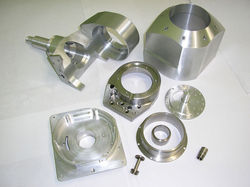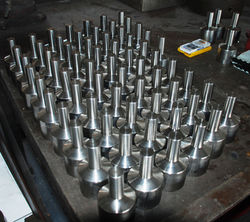

3791 Edison Ave. Ft. Myers, Fl. 33916
Phone: (239) 332-2841 E-mail: info@apmachineshop.com
Hours: 7:00am - 3:30pm
Manual Machining
 |  |
|---|---|
 |  |
 |  |
 |  |
 |  |
 |
Manual machining, also known as conventional machining or traditional machining, refers to the process of shaping and manipulating materials using manually operated tools and equipment. Unlike CNC machining, which relies on computerized controls, manual machining involves skilled operators who control the machines and tools by hand.
-
Lathe Operations: Manual machining often involves the use of a lathe, which is a machine tool used for rotating a workpiece against a cutting tool. The operator manually adjusts the tool's position and feed rate to remove material and shape the workpiece. Lathe operations include turning, facing, grooving, threading, and tapering.
-
Milling Operations: Manual milling machines are used for milling operations, which involve removing material from a workpiece using rotary cutters. The operator manually positions the workpiece and controls the movements of the milling cutter to achieve desired shapes, slots, or contours. Milling operations include face milling, end milling, drilling, and slotting.
-
Drilling Operations: Manual drilling involves creating holes in a workpiece using a drilling machine or drill press. The operator manually feeds the drill bit into the workpiece to produce holes of specific sizes and depths.
-
Grinding Operations: Manual grinding is performed to achieve precise surface finishes or dimensional accuracy. Operators use manually operated grinding machines, such as surface grinders or cylindrical grinders, to remove material and refine the surface of the workpiece.
-
Sawing Operations: Manual sawing is used to cut workpieces into desired lengths or shapes. Manual saws, such as band saws or hacksaws, are operated by hand to cut through various materials, including metals, plastics, or wood.
-
Filing and Deburring: Manual machining often involves filing and deburring operations to smooth rough edges, remove burrs, or refine part surfaces. Hand files, abrasive papers, or deburring tools are used by operators to achieve the desired finish and ensure part quality.
-
Assembly and Finishing: Manual machining may also include assembly operations, where machined components are joined together manually using fasteners, adhesives, or welding. Additionally, manual machining may involve various finishing operations, such as sanding, polishing, or surface treatments, to enhance the appearance and functionality of the final product.
Manual machining requires skilled operators who possess a deep understanding of machining principles, materials, and tooling techniques. They rely on their expertise, experience, and precision to achieve accurate results. While manual machining is often associated with traditional methods, it continues to be utilized in situations where custom or low-volume production, intricate designs, or specialized applications are involved.
When seeking manual machining services, it is important to collaborate with skilled machinists or machining shops that have the necessary expertise, equipment, and attention to detail. Clear communication of design specifications, material requirements, and quality expectations is vital to ensure the successful execution of your project. Advanced Precision Machine has some of the most experienced manual machinists around. If you need work with attention to detail, this is the place to come.